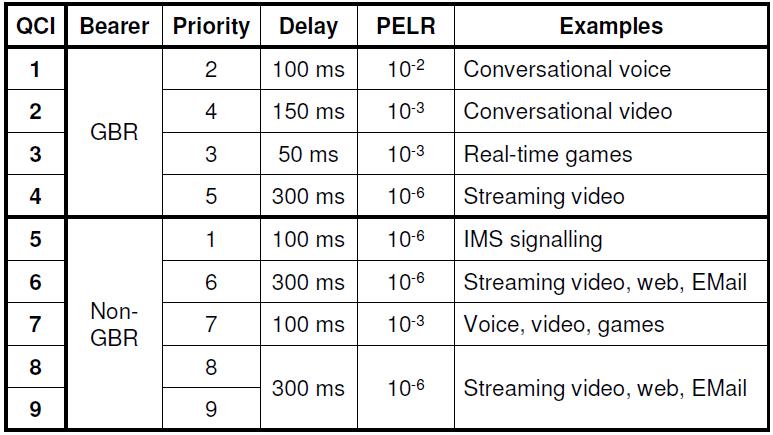EPS Bearer Terminology in LTE
This article breaks down key concepts, including Quality of Service, GBR (Guaranteed Bit Rate) Bearers, Non-GBR Bearers, and crucial parameters like QoS Class Identifier (QCI) and Allocation and Retention Priority (ARP).

Quality of service
- GBR bearer: Guaranteed bit rate
- Non-GBR bearer: No guaranteed bit rate
Establishment time
- Default bearer
- Established when UE connects to PDN
- Provides always-on connectivity
- Always non-GBR
- Dedicated bearer established later
- Can be GBR or non-GBR
Every EPS bearer
- QoS class identifier (QCI): This is a number which describes the error rate and delay that are associated with the service.
- Allocation and retention priority (ARP): This determines whether a bearer can be dropped if the network gets congested, or whether it can cause other bearers to be dropped. Emergency calls might be associated with a high ARP.
Quality of Service: The Core Element
At the heart of EPS Bearers lies the concept of Quality of Service (QoS). QoS determines the level of service quality that a network can provide to different types of data traffic. In LTE, QoS is crucial for ensuring that diverse applications, from video streaming to voice calls, receive the appropriate level of service.
GBR Bearer: Guaranteed Bit Rate
One fundamental aspect of EPS Bearers is the differentiation between GBR and Non-GBR Bearers. Let’s start by understanding GBR Bearers:
What is GBR?
GBR, or Guaranteed Bit Rate, is a type of EPS Bearer that ensures a specific, guaranteed rate of data transmission. This means that for applications sensitive to latency and requiring a constant and predictable data flow, GBR Bearers are the go-to choice.
Non-GBR Bearer: No Guaranteed Bit Rate
On the flip side, we have Non-GBR Bearers, which are characterized by the absence of guaranteed bit rates. These bearers are more suitable for applications where occasional delays or variations in data flow are acceptable.
Establishment Time: Default vs. Dedicated Bearer
The timing of bearer establishment is a critical distinction in LTE networks, as it determines when and how connectivity is established. There are two primary types of bearers: Default Bearers and Dedicated Bearers.
Default Bearer
Established when UE connects to PDN
The Default Bearer is the initial bearer established when a User Equipment (UE) connects to a Packet Data Network (PDN). It serves as the foundation for the UE’s connection to the network.
Provides always-on connectivity
One of the key characteristics of Default Bearers is that they provide always-on connectivity. This means that as long as the UE is active, this bearer remains connected.
Always non-GBR
Another defining feature of Default Bearers is that they are always Non-GBR. This makes them suitable for applications that don’t require guaranteed bit rates.
Dedicated Bearer
Established later
Dedicated Bearers, on the other hand, are established after the Default Bearer. They come into play when specific QoS requirements or service characteristics demand a different treatment of data traffic.
Can be GBR or non-GBR
Dedicated Bearers offer flexibility when it comes to the type of service they provide. They can be either GBR or Non-GBR, depending on the specific needs of the application.
Key Parameters for Every EPS Bearer
Regardless of whether it’s a GBR or Non-GBR Bearer, each EPS Bearer is associated with critical parameters that define its behavior and characteristics. Two of the most important parameters are the QoS Class Identifier (QCI) and the Allocation and Retention Priority (ARP).
QoS Class Identifier (QCI)
The QoS Class Identifier (QCI) is a numerical value that serves as a crucial descriptor of the error rate and delay associated with a particular service. In essence, it categorizes the QoS requirements of different applications or services.
Understanding QCI Values
QCI values range from 1 to 9, with each value representing a specific set of QoS characteristics. For instance:
- QCI 1: Represents the highest priority with the lowest packet delay and packet loss.
- QCI 9: Represents the lowest priority with the highest packet delay and packet loss tolerance.
By assigning the appropriate QCI value to a bearer, the network ensures that the service receives the desired QoS level.
Allocation and Retention Priority (ARP)
Allocation and Retention Priority (ARP) is a critical parameter that determines the priority of an EPS Bearer in situations of network congestion. In essence, ARP helps the network decide which bearers to drop first when resources become scarce.
Emergency Calls and High ARP
Emergency calls, which demand the highest level of service quality, are typically associated with a high ARP. This means that in congested network conditions, bearers with lower ARP values may be dropped to ensure the continuity of emergency services.
In conclusion, understanding EPS Bearer Terminology in LTE is pivotal for network engineers, service providers, and anyone involved in the world of telecommunications. Whether it’s ensuring guaranteed bit rates with GBR Bearers, accommodating diverse applications with Non-GBR Bearers, or fine-tuning QoS with parameters like QCI and ARP, mastering these concepts is essential for delivering reliable and efficient LTE services.